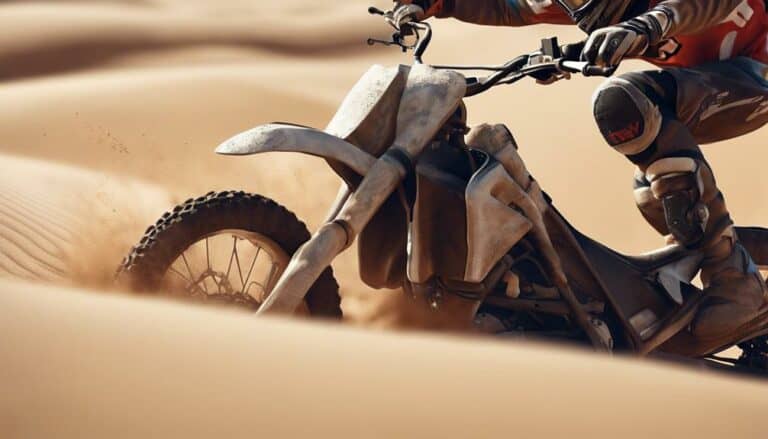When tackling sandy terrains with your dirt bike, have you considered how your gear selection plays an essential role in managing the challenging conditions?
The unique demands of sand call for specific adjustments to optimize your riding experience. From gear ratio considerations to specialized gear modifications, understanding the nuances of gear selection on sandy surfaces can make a significant difference in your performance.
Explore how these tailored gear choices can enhance your control and traction on the shifting sands, ultimately shaping your off-road adventure in unexpected ways.
Key Takeaways
- Optimal gear selection balances power and control for acceleration and traction on sandy terrains.
- Lower gear ratios enhance torque and acceleration, while higher ratios maintain speed and momentum.
- Precise throttle control and RPM management are crucial for traction and power delivery in sandy conditions.
- Adjusting tire pressure, gear ratios, and suspension settings improves stability, traction, and overall performance on sand.
Importance of Gear Selection on Sandy Terrains
When tackling sandy terrains on a dirt bike, selecting the appropriate gear ratios is essential for optimizing acceleration, power, and control throughout your ride. The gear selection plays a critical role in your ability to maneuver through the challenging conditions of sandy surfaces. Lower gear ratios with smaller front sprockets are advantageous in sandy terrains as they provide increased acceleration and power, helping you navigate through the loose and shifting sands more effectively.
Conversely, opting for higher gear ratios with larger rear sprockets can assist in maintaining speed and momentum on sandy surfaces where traction may be limited. By adjusting your gear selection accordingly, you can prevent wheel spin and loss of control by ensuring your dirt bike has the necessary torque and power to handle the demanding environment.
Gear Ratio Considerations for Sand Riding
Consider adjusting your gear ratios to optimize traction and control when riding a dirt bike on sandy terrains. To enhance your riding experience on the soft and shifting sands, follow these gear ratio considerations:
- Use Larger Rear Sprockets: Opt for larger rear sprockets to improve traction and control in loose sandy conditions.
- Gear Down for Lower Ratios: Lower gear ratios provide increased torque and power delivery, aiding in navigating through the soft sand effectively.
- Wider Tires with Lower Pressure: Choose wider tires and lower tire pressure to float on top of the sand, preventing sinking and enhancing stability.
- Adjust Suspension Settings: Modify suspension settings to adapt to the shifting sands, maintaining stability and handling on sandy terrains.
- Balance Power and Control: Achieve a balance between power and control by selecting gear ratios that enhance traction and prevent bogging down in the sandy environment.
Optimal Gear Shifting Techniques for Sand
Optimizing gear shifting techniques for riding a dirt bike on sandy terrains involves precise throttle control and strategic RPM management to maintain traction and momentum.
When tackling sandy surfaces, it's essential to gear down to prevent the bike from bogging down and losing control. Lower gears provide smoother acceleration and improved maneuverability in the loose and shifting sand.
To navigate sandy sections effectively, opt for higher RPMs in lower gears to make continuous power delivery and prevent the bike from getting stuck. By mastering clutch control and throttle modulation, you can tailor your gear selection based on the depth and consistency of the sand.
Balancing power delivery with wheel spin is essential to maintaining forward momentum and control over the bike in sandy conditions. Remember, strategic gear selection is key to conquering sandy terrains and ensuring a thrilling and successful ride.
Impact of Tire Pressure on Sandy Terrains
To maintain prime traction and control on sandy terrains, adjusting tire pressure is a critical factor in enhancing your dirt bike's performance. Proper tire pressure plays a significant role in how your bike handles the sandy conditions, affecting traction and stability. Here are five key points to keep in mind regarding tire pressure on sandy terrains:
- Lower tire pressure on sandy terrains increases the tire's footprint, providing better traction and floatation.
- Reduced tire pressure allows the tires to conform to the sandy surface, enhancing stability and control.
- Lower tire pressure helps prevent the bike from sinking into the sand, maintaining momentum and speed.
- Proper tire pressure adjustment is essential to prevent tire spin and maintain forward progress on sandy terrains.
- The recommended tire pressure for sandy conditions is typically lower than standard pressure settings for improved handling and performance.
Special Gear Modifications for Sand Riding
For enhanced performance on sandy terrains, modifying your gear setup is essential to optimize traction and control. As a dirt biker seeking to conquer sandy trails, there are specific gear modifications you can make to enhance your riding experience.
Consider equipping your bike with wider rear sprockets to improve traction in the loose sand. Lowering tire pressure is another important adjustment that increases the tire's footprint, providing better control on the shifting surface.
Opting for paddle tires with specialized tread patterns designed for sand riding can greatly enhance your grip and maneuverability in these challenging conditions. Additionally, adjusting your suspension settings to accommodate the softer nature of sand will help you navigate the terrain more effectively.
Implementing a higher gear ratio can also boost your top speed while maintaining traction on sandy trails. By incorporating these gear modifications tailored for sand riding, you can elevate your trail riding performance and tackle sandy terrains with confidence and ease.
Conclusion
To sum up, when riding a dirt bike on sandy terrains, proper gear selection is essential for improving traction and control.
Did you know that adjusting tire pressure can greatly impact your performance on sand? By lowering your tire pressure, you can increase the surface area of the tire in contact with the sand, providing better grip and stability.
Remember, mastering gear selection and tire pressure adjustments will help you conquer sandy terrains with confidence and skill.

